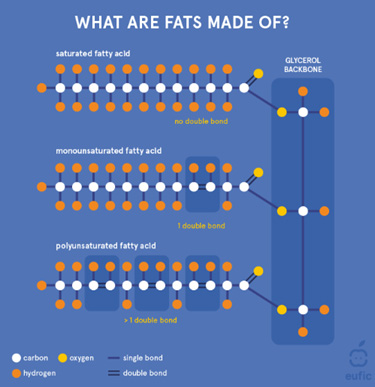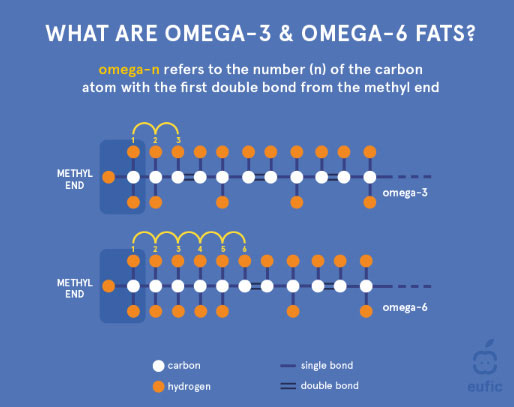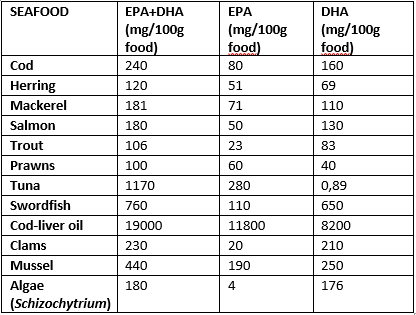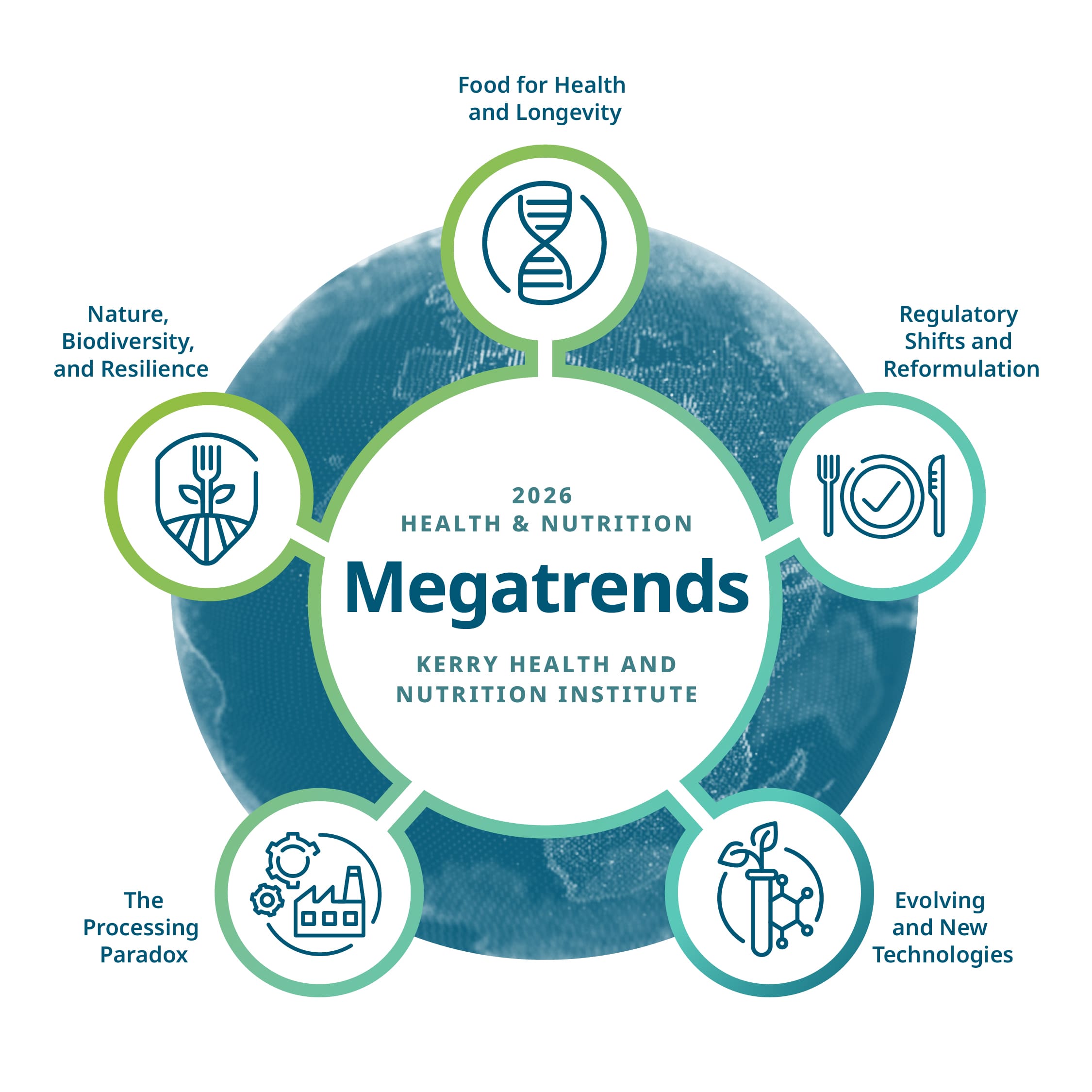The role of fatty acids in the body
Dietary fats are essential for human health, especially omega-3 fatty acids due to their role in eye health, brain health, heart health, and more, yet very few people get enough of these fats from their diet. Dietary guidelines recommend consuming approximately 30% of total daily calories from fat, which is a significant proportion of the diet, however the quality and composition of fat is an important consideration. Essential fatty acids, such as those in omega-3, serve many important roles in the body.
An important part of a healthy diet
Fats provide an efficient source of energy (9kcal/g) when consumed, and any excess is stored as fat within adipose tissue as an energy reserve. This adipose tissue provides insulation and protection for vital organs and helps to maintain body temperature at 37°C. Essential fat soluble vitamins (A,D,E,K) require fat for absorption and functionality within the body. Fats are a main component of every cell membrane in our body, enabling cell communication, particularly within the brain and nervous system. The human brain is made up of approximately 60% fat. Fats also serve as important messengers within the body, as precursors to hormones, immune cells and neurotransmitters. Needless to say, fats are an important part of a healthy diet.

Fats in diet are classified in 3 distinct categories; saturated fats (SFA – no double bonds in the acyl chain of the fatty acid), monounsaturated fats (MUFA – one double bond), or polyunsaturated fats (PUFA – two or more double bonds). The different structures among these types of lipids determine their function in the body as well as in foods or beverages.

Fatty acids are categorized by the number of double bonds they have in their structure. The different makeup of these fatty acids will be related to a specific type of fat’s function in the body. Source: European Food Information Council (EUFIC)
In a healthy diet, MUFA and PUFA, (found in fish, avocado and nuts, and in sunflower, soybean, canola and olive oils) are preferable to SFA, (found in fatty meat, butter, palm and coconut oil, cream, cheese, ghee and lard). This is due to the associated risk of cardiovascular disease with SFA which has been evident in many longitudinal studies globally. Therefore, WHO recommends limiting the intake of saturated fats to less than 10% of total energy intake.
We will focus here on the functions of PUFAs in health. There are two families of PUFAs, namely the omega-6 and the omega-3 groups. This nomenclature refers to the carbon position in which the first double bond is present in the fatty acid chain.

Source: European Food Information Council (EUFIC)
Both omega-3 and omega-6 fatty acids are important components of cell membranes and are precursors to many other substances in the body such as those involved in regulating blood pressure and inflammatory responses.
The human body is capable of producing all of the fatty acids it needs, except for two: linoleic acid (LA) – an omega-6 fatty acid, and alpha-linolenic acid (ALA) – an omega-3 fatty acid. These are termed ‘essential fatty acids’ and they must be consumed it in the diet. LA and ALA can be found in nuts, seeds, and plant oils such as rapeseed and walnut oil. There are also longer chain omega-3 fats, eicosapentaenoic (EPA; 20:5 n-3) and docosahexaenoic (DHA; 22:6 n 3), which can be synthesized from ALA or obtained from oily fish (e.g. salmon, mackerel, herring). The conversion from ALA, such as those found in plant oils, is not an efficient conversion ratio and requires a high amount of ALA consumption to produce a small amount of DHA or EPA. Consumption of DHA or EPA directly from marine sources, such as fish or algae, is often the preferred method encouraged by dietary guidelines globally. These long chain PUFA’s have been shown to have protective health benefits for brain and cardiovascular health.
Functions of Omega-3 fats (EPA/DHA) in the body
Fatty acids are an integral component of cell membrane phospholipids, with specific function, metabolic, and signalling roles. Different cell types have different fatty acid compositions that influence membrane fluidity, flexibility and cell signalling modulating gene expression (Calder 2015).
It can be helpful to think about the nature of these fats in food at different temperatures to imagine how each fat type would have a different role in the body. Saturated fats are typically solid at room temperature (e.g. butter, palm oil), but fats become more fluid as there is more unsaturation in the fatty acid chain. PUFAs stay fluid even at low temperatures. This is one reason why you will find a lot of omega-3 fats in cold water fish – these fats can help the fish’s cell membranes stay fluid in cold water temperatures. Similarly, you will find a higher concentration of omega-3 fats in body tissues that need a high amount of fluidity, such as the eyes, heart, or brain.
These fats are also important in inflammatory biochemical pathways, meaning they have roles in immune function and mediating inflammatory conditions in the body. These structural or inflammatory roles are often related to the links to health outlined below.
Brain function and development
DHA is the most abundant omega-3 fatty acid in the central nervous system and plays a key role in its function and maintenance (Djuricic and Calder 2021). It is important for neurotransmission (communication of signals between neurons), neuroplasticity (the ability of the brain to adapt throughout life by reforming or creating new neural networks) and signal transduction.
In this context, the role of DHA in prenatal and early postnatal brain and visual development is remarkable. Brain development is a complex process that starts in the prenatal phase. It is well known how mother´s nutrition during pregnancy and breastfeeding impacts offspring development. Consumption of DHA-rich diets in mothers has been linked to higher DHA levels in infants, which has been associated with enhanced infant neurodevelopment (Nyaradi et al 2013; Basak and Duttaroy 2022). The early roles of DHA in cognitive and visual development are considered well-supported, so DHA is a mandatory ingredient in infant formula in many regions.

Beyond the benefits of DHA in brain development, some additional benefits on cognitive function as well as on psychological, psychiatric, and behavioural disorders have been described. A positive association has been reported between intake/blood levels of DHA and memory function (Yurko-Mauro et al 2015). Although some effects on memory function have been observed in younger populations (Petrova et al 2019), it is more evident in older populations with a significant impact on risk of cognitive decline, dementia, and Alzheimer’s disease (Zhang et al 2016; Marti del Moral 2019). The links between omega-3 fats and memory and cognitive function are still an emerging area of science.
Eye health and development
As in the brain, the most abundant fatty acid in the retina is DHA. This fatty acid contributes to eye development and function through its signalling and structural effects on retinal photoreceptor cells (Shindou et al 2017; Senapati et al 2018). Its antioxidant and anti-inflammatory role have been described as key for maintaining healthy retinal cells. In fact, a possible protective role of DHA and their derivatives has been attributed in the pathogenesis of retinal diseases (retinopathies) like age-related macular degeneration or diabetic retinopathy (Lafuente et al 2021; Wu et al 2017).
Heart health
Cardiovascular health is the most studied area of omega-3 fatty acids in human health. As early as 1944, Sinclair described the rarity of coronary heart disease amongst Greenland Eskimos who consumed a diet rich in fish, seal, and whale (Sinclair 1953). Since the first studies were published in the 1980s linking the consumption of high dietary intake of EPA/DHA with a low rate of mortality from myocardial infarction and ischaemic heart disease, the protective role of these fatty acids has been extensively studied.
More recently, the largest prospective cohort study conducted to date included ~420,000 participants from the National Institutes of Health AARP Diet and Health Study with a 16-year follow-up and reported a significant inverse association between fish and EPA + DHA intake and various mortality outcomes (Zhang et al 2018). Comparing the highest with lowest quintiles of fish EPA + DHA intake was associated with 15% and 18% lower CVD mortality in men and women, respectively, across extreme quintiles (groups of people who consumed the highest vs lowest amounts of fish EPA + DHA).
How do EPA/DHA reduce risk for heart disease? Studies have suggested it could be due to the improvement of different risk factors like blood pressure, serum triglycerides, high-density lipoprotein (HDL)-cholesterol, post-prandial lipaemia, endothelial dysfunction, cardiac arrhythmia, heart rate and heart rate variability and inflammation (Sakamoto et al 2019; Zhang et al 2022; Mendivil 2021).
Joint and muscle
Other potential roles of omega-3 fats in health are constantly being studied. EPA/DHA fatty acids have been found to counteract the onset and progression of osteo-arthritis by reducing bone and cartilage destruction. This benefit has been related to the anti-inflammatory and antioxidant activity (Oppedisano et al 2021). Several studies also suggest a potentially beneficial effect of EPA/DHA on physical performance by improved endurance capacity and delayed onset of muscle soreness, as well as on markers related to enhanced recovery and immune modulation (Thielecke and Blannin 2020).
Skin health
Emerging evidence is showing a role of omega-3 fats in skin health, possibly due to the role of these fats in mediating inflammation. Several small studies have shown omega-3 fats can improve skin barrier function, but larger studies will need to confirm this (Parke et al 2021).
Sources of Omega-3 Fatty Acids
The main sources of EPA and DHA in diet are seafood and fish, especially fatty fish like salmon, tuna, swordfish etc. The specific concentrations of EPA and DHA depends on the species (Table 1). Due to the link of omega-3 fats to health, many dietary recommendations include fatty fish 1-2 times per week as part of a healthy diet.
In addition to food, the consumption of supplements containing fish or algae oils has become an increasingly common alternative for omega-3 consumption. Algae oil is a sustainable plant-based option that is gaining interest in recent years. Species such as Schizochytrium, Crypthecodinium, Euglena and Nannochloropsis are mainly used because of their high omega-3 content.

Average content of omega 3 EPA and DHA fatty acids in fish and seafood. Source: United States Department of Agriculture. Agricultural Research Service. National Nutrient Database for Standard Reference
How much omega-3 is recommended and how much do people consume?
Although omega 3 intake recommendations can slightly differ among countries, in general, most governments recommendations suggest consuming 2-3 servings (200-300 g) of fatty fish per week (~35g/d average) to achieve 250 mg of EPA and DHA per day.
However, consumption differs greatly among different regions (Micha et al 2014). The countries that consume more fish per day are in the Asia-Pacific areas such as Japan (intake 81.3 g/d) in contrast to countries in the geographic areas of Central America, Central and South Asia and sub-Saharan Africa in which mean of fish daily consumption is around 10-15 g/day. In Europe, the average is about 35 g per day but with considerable variability between different countries. In the US the average fish consumption is 20.1 g/day, similar to Canada’s. In fact, data show that in the US less than 15% of population reaches the recommended fish intake (Rehm et al 2016). Therefore, a higher intake of fish should be promoted in population to benefit from its positive effects on health. The use of food supplements containing EPA/DHA rich fish or algae oils can also help to reach the recommended EPA/DHA intake.
Although EPA/DHA intake recommendations may slightly differ among countries, in general, recommendations are adjusted depending on specific needs of population (table 2).

Table 2: EPA/DHA omega 3 recommended intakes in Europe (EU) and US. Sources: EFSA, American Academy of Pediatrics, Institute of Medicine, WHO, National Research Council recommended allowance.
These recommendations are based on the scientific evidence about health benefits associated to the EPA/DHA consumption accumulated over the last decades. This scientific evidence supports health claims associating specific health benefits to EPA/DHA consumption in certain parts of the world, such as the examples from Europe below. Claims need to be validated based on local regulations.
- DHA and EPA contribute to the normal function of the heart (250 mg/day).
- DHA contributes to maintenance of normal brain function (250 mg/day).
- DHA contributes to the maintenance of normal vision (250 mg/ day).
Omega-3 fatty acid supplementation
As mentioned above, only a low percentage of countries reach dietary fish consumption that provides the recommended intake of EPA/DHA. The use of functional foods and supplements are the easy and affordable solution to complement dietary deficiencies in the supply of omega 3 in the diet.
The advancement of technology makes it possible to have fish and algae oils rich in EPA and/or DHA omega 3 fatty acids with excellent quality and taste characteristics. It is interesting to note that the fish oil refining processes also remove certain pollutants affecting the oceans which are accumulate in fish, such as heavy metals, plastic derivatives or pesticides.
These EPA/DHA rich oils can be easily incorporated to frequently consumed foods such as dairy products, juices, bakery, cereals etc thus ensuring a balanced and convenient supply of these important fatty acids in diet.
On the other hand, in the field of supplements, which is considered the main market for Omega-3, there is a wide range of formulations where high concentrates are mainly used. At the format level, we find, for example, gummies and syrups for children or capsules, gels, shoots, etc for adults.
Sustainably sourcing omega-3 fats
Our society is increasingly aware of the importance of protecting the environments natural resources. Habitat destruction, pollution and ocean acidification caused by unsustainable fishing, maritime trade and other human activities have caused a serious deterioration in the health of the seas, putting access to vital marine resources at risk for future generations. Fortunately, most of the fisheries from which fish or other marine omega-3 oils are obtained are subject to strict audits that verify environmental standards, thus verifying the use of more sustainable practices when it comes to fishing. Among the most important certifications in terms of sustainability are: Marine Stewardship Council (MSC), Friend of the Sea and MarinTrust, which certifies that marine ingredients are obtained and produced responsibly.
Plant-based sources omega-3: algae
Algae is a plant-based alternative source of omega-3 fatty acids. It contains helps reduce pressure on marine resources such as overfishing and promotes a more sustainable ecosystem because it is able to trap carbon dioxide similar to terrestrial plants.
The algae can be grown in open ponds or fermented in tanks and growing conditions are optimized to obtain omega 3 rich oil with concentrations comparable than those found in fish oils. A typical algal oil may contain 400 mg of EPA + DHA per gram of oil, compared to 300 mg in a standard fish oil, or 0 mg in a flaxseed oil. For those seeking a plant-based source of omega-3, algae can serve as a direct source of EPA + DHA compared to other plant-based oils, which contain alpha-linoleic acid and must be converted by the body into EPA + DHA.

Omega-3 fats are essential for health, yet in many parts of the world people are not meeting the recommended daily intakes. Public health messaging should encourage the consumption of sustainably sourced oily fish, algae and associated supplements, to maximize the public health benefits while protecting natural resources for future generations.
Contributors:
-
References
Bae, J.H.; Kim, G. Systematic review and met-analysis of omega-3-fatty acids in elderly patients with depression. Nutr. Res. 2018, 50, 1–9.
Basak S, Duttaroy AK. Maternal PUFAs, Placental Epigenetics, and Their Relevance to Fetal Growth and Brain Development. Reprod Sci. 2022 Jun 8. doi: 10.1007/s43032-022-00989-w
Calder, P.C. Functional roles of fatty acids and their effects on human health. J. Parenter. Enter. Nutr. 2015, 39, 18S–32S.
de la Torre-Aguilar MJ, Gomez-Fernandez A, Flores-Rojas K, Martin-Borreguero P, Mesa MD, Perez-Navero JL, Olivares M, Gil A, Gil-Campos M. Docosahexaenoic and Eicosapentaenoic Intervention Modifies Plasma and Erythrocyte Omega-3 Fatty Acid Profiles But Not the Clinical Course of Children With Autism Spectrum Disorder: A Randomized Control Trial. Front Nutr. 2022 Mar 29;9:790250
Deane, K.H.O.; Jimoh, O.F.; Biswas, P.; O’Brien, A.; Hanson, S.; Abdelhamid, A.S.; Fox, C.; Hooper, L. Omega-3 and polyunsaturated fat for prevention of depression and anxiety symptoms: Systematic review and meta-analysis of randomised trials. Br. J. Psychiatry 2021, 218, 135–142.
Djuricic I and Calder PC. Beneficial Outcomes of Omega-6 and Omega-3 Polyunsaturated Fatty Acids on Human Health: An Update for 2021. Nutrients 2021, 13, 2421.
Guu T-W, Mischoulon D, Sarris J, Hibbeln J et al. International Society for Nutritional Psychiatry Research Practice Guidelines for Omega-3 Fatty Acids in the Treatment of Major Depressive Disorder. Psychother Psychosom. 2019;88(5):263-273).
Lafuente M, Rodríguez González-Herrero ME, Romeo Villadóniga S, Domingo JC. Antioxidant Activity and Neuroprotective Role of Docosahexaenoic Acid (DHA) Supplementation in Eye Diseases That Can Lead to Blindness: A Narrative Review. Antioxidants (Basel). 2021 Mar 5;10(3):386;
Liao, Y.; Xie, B.; Zhang, H.; He, Q.; Guo, L.; Subramaniapillai, M.; Fan, B.; Lu, C.; Mclntyer, R.S. Efficacy of omega-3 PUFAs in depression: A meta-analysis. Transl. Psychiatry 2019, 9, 190
Marti, Amelia & Fortique, Francesca. (2019). Omega-3 fatty acids and cognitive decline: a systematic review. Nutrición Hospitalaria. 36. 10.20960/nh.02496.
Mason RP, Libby P, Bhatt DL. Emerging Mechanisms of Cardiovascular Protection for the Omega-3 Fatty Acid Eicosapentaenoic Acid. Arterioscler Thromb Vasc Biol. 2020;40:1135–1147
Mazahery H, Stonehouse W, Delshad M, Kruger MC, Conlon CA, Beck KL, von Hurst PR. Relationship between Long Chain n-3 Polyunsaturated Fatty Acids and Autism Spectrum Disorder: Systematic Review and Meta-Analysis of Case-Control and Randomised Controlled Trials. Nutrients. 2017 Feb 19;9(2):155.)
Mazidimoradi A, Alemzadeh E, Alemzadeh E, Salehiniya H. The effect of polyunsaturated fatty acids on the severity and mortality of COVID patients: A systematic review. Life Sci. 2022 Jun 15;299:120489.
Mendivil CO (2021) Dietary Fish, Fish Nutrients, and Immune Function: A Review. Front. Nutr. 7:617652. doi: 10.3389/fnut.2020.617652
Micha R, Khatibzadeh S, Shi P, Fahimi S, Lim S, Andrews KG, Engell RE, Powles J, Ezzati M, Mozaffarian D; Global Burden of Diseases Nutrition and Chronic Diseases Expert Group NutriCoDE. Global, regional, and national consumption levels of dietary fats and oils in 1990 and 2010: a systematic analysis including 266 country-specific nutrition surveys. BMJ. 2014 Apr 15;348:g2272
Nyaradi A, et al. The role of nutrition in children’s neurocognitive development, from pregnancy through childhood. Front Hum Neurosci. 2013;7:97.
Oppedisano F, Bulotta RM, Maiuolo J, Gliozzi M, Musolino V, Carresi C, Ilari S, Serra M, Muscoli C, Gratteri S, Palma E, Mollace V. The Role of Nutraceuticals in Osteoarthritis Prevention and Treatment: Focus on n-3 PUFAs. Oxid Med Cell Longev. 2021 Dec 10;2021:4878562.
Parke MA, Perez-Sanchez A, Zamil DH, Katta R. Diet and Skin Barrier: The Role of Dietary Interventions on Skin Barrier Function. Dermatol Pract Concept. 2021 Jan 29;11(1):e2021132
Petrova D, Litrán MAB, García-Mármol E et al. 2018. Effects of fortified milk on cognitive abilities in school-aged children: results from a randomized-controlled trial. Eur J Nutr . 2019 Aug;58(5):1863-1872.
Rehm CD, Peñalvo JL, Afshin A, Mozaffarian D. Dietary Intake Among US Adults, 1999-2012. JAMA. 2016 Jun 21;315(23):2542-53.
Richardson A.J. Clinical trials of fatty acid treatment in ADHD, dyslexia, dyspraxia and the autistic spectrum. Prostaglandins Leukot. Essent. Fat. Acids. 2004;70:383–390
Rodríguez C, García T, Areces D, Fernández E, García-Noriega M, Domingo JC. Supplementation with high-content docosahexaenoic acid triglyceride in attention-deficit hyperactivity disorder: a randomized double-blind placebo-controlled trial. Neuropsychiatr Dis Treat. 2019 May 8;15:1193-1209
Sakamoto A, Saotome M, Iguchi K and Maekawa Y. Marine-Derived Omega-3 Polyunsaturated Fatty Acids and heart failure: Current understanding for basic to clinical relevance. Int. J. Mol. Sci. 2019, 20, 4025).
Sartorio MUA, Pendezza E, Coppola S, Paparo L, D’Auria E, Zuccotti GV, Berni Canani R. Potential Role of Omega-3 Polyunsaturated Fatty Acids in Pediatric Food Allergy. Nutrients. 2021 Dec 29;14(1):152).
Senapati, S.; Gragg, M.; Samuels, I.S.; Parmar, V.M.; Maeda, A.; Park, P.S.-H. Effect of dietary docosahexaenoic acid on rhodopsin content and packing in photoreceptor cell membranes. Biochim. Biophys. Acta Biomembr. 2018, 1860, 1403–1413
Shindou H., Koso H., Sasaki J., Nakanishi H., Sagara H., Nakagawa K.M., Takahashi Y., Hishikawa D., Iizuka-Hishikawa Y., Tokumasu F., et al. Docosahexaenoic acid preserves visual function by maintaining correct disc morphology in retinal photoreceptor cells. J. Biol. Chem. 2017;292:12054–12064;
Sinclair H.M. The Diet of Canadian Indians and Eskimos. Proc. Nutr. Soc. 1953;12:69–82
Thielecke F, Blannin A. Omega-3 Fatty Acids for Sport Performance-Are They Equally Beneficial for Athletes and Amateurs? A Narrative Review. Nutrients. 2020 Nov 30;12(12):3712).
Wu, J.; Cho, E.; Giovannucci, E.L.; Rosner, B.A.; Sastry, S.M.; Willett, W.C.; Schaumberg, D.A. Dietary Intakes of Eicosapentaenoic Acid and Docosahexaenoic Acid and Risk of Age-Related Macular Degeneration. Ophthalmology 2017, 124, 634–643).
Yurko-Mauro, K.; Alexander, D.D.; Van Elswyk, M.E. Docosahexaenoic acid and adult memory: A systematic review and meta-analysis. PLoS ONE 2015, 10, e0120391
Zhang, X.W.; Hou,W.S.; Li, M.; Tang, Z.Y. Omega-3 fatty acids and risk of cognitive decline in the elderly: A meta-analysis of randomized controlled trials. Aging Clin. Exp. Res. 2016, 28, 165–166.
Zhang, Y.; Zhuang, P.; He, W.; Chen, J.N.; Wang, W.Q.; Freedman, N.D.; Abnet, C.C.; Wang, J.B.; Jiao, J.J. Association of fish and long-chain omega-3 fatty acids intakes with total and cause-specific mortality: Prospective analysis of 421 309 individuals. J. Intern. Med. 2018, 284, 399–417.

 Mónica graduated in Pharmacy from the University of Granada in Spain and did her doctoral thesis on molecular biology at a Research Center of the Spanish National Research Council (CSIC). She specializes in probiotic strains isolated from human milk and is the author of 80 scientific publications, more than 40 related to probiotics, and is also listed as an inventor on 8 patents, 3 of them on probiotics.
Mónica graduated in Pharmacy from the University of Granada in Spain and did her doctoral thesis on molecular biology at a Research Center of the Spanish National Research Council (CSIC). She specializes in probiotic strains isolated from human milk and is the author of 80 scientific publications, more than 40 related to probiotics, and is also listed as an inventor on 8 patents, 3 of them on probiotics.  Pharmacist with 5 years of experience in sales and over 9 years in Marketing. Worked in pharmaceuticals, nutraceuticals and F&B companies. Persistent, creative and responsible. Willing to improve and learn from others to grow professionally and personally.
Pharmacist with 5 years of experience in sales and over 9 years in Marketing. Worked in pharmaceuticals, nutraceuticals and F&B companies. Persistent, creative and responsible. Willing to improve and learn from others to grow professionally and personally.  Dr. Izaskun Monsalve, Marketing Manager for Women’s Health at Kerry. Izaskun has over 20 years of experience and currently leads Kerry’s Global Marketing for women’s and infant health. She has a degree in pharmacy from the Complutense University of Madrid with a PhD in biotechnology and an MBA.
Dr. Izaskun Monsalve, Marketing Manager for Women’s Health at Kerry. Izaskun has over 20 years of experience and currently leads Kerry’s Global Marketing for women’s and infant health. She has a degree in pharmacy from the Complutense University of Madrid with a PhD in biotechnology and an MBA. 

